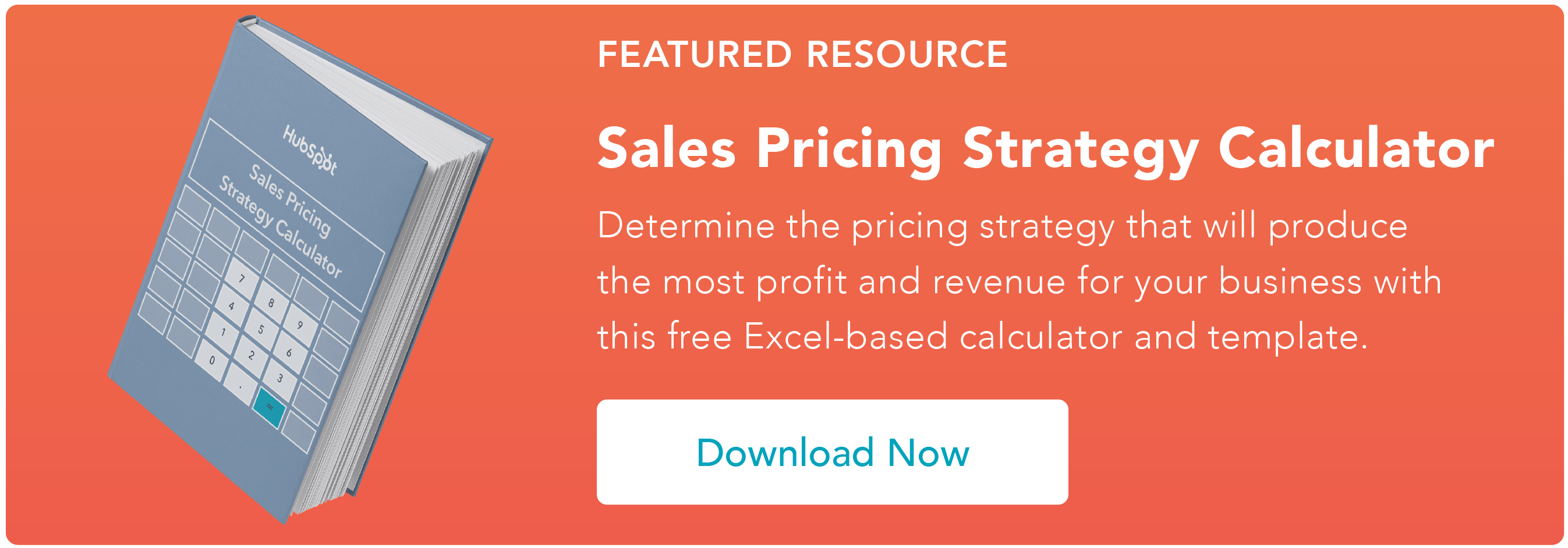How to Sell Expensive Products
- Understand your buyer persona.
- Use a high-ticket sales script.
- Help them envision what success looks like.
- Figure out your competition.
- Eliminate low-quality competitors.
- Talk price only after you're in the lead.
- Ask about when low-cost choices let them down.
- Use examples of customers who switched from a less-pricey option.
- Use a trial close.
- Close for the technical win.
- Learn stakeholders’ buying histories.
- Formally close for a champion.
1. Understand your buyer persona.
Your product likely solves a specific pain or problem your ideal buyer is experiencing. It's not enough to talk nuts and bolts, features and pricing... especially in high-ticket sales.
You'll need to identify your prospect's motivations, pains, and triggering events — perhaps before they even pick up the phone. To do that, create a buyer persona of your ideal customer and explore why they'd consider a premium solution for their situation.
The information can give you an edge while building rapport, and you'll have a profile to compare against as you qualify prospects.
2. Use a high-ticket sales script.
Your conversation will take you in a number of directions, so it's okay to rely on your knowledge of the product/service and competitors during your sales calls. However, to sharpen your sales process, you should have a sales script for the primary stages of each deal:
Intro:
The goal of the intro is to, of course, introduce yourself but also get their attention as quickly as possible.
"Hello [Prospect Name]. I'm [Your Name], and I help [Their Title] like you [What Your Product/Service Solves]."
Then, you'll lead into the conversation with an open-ended question. For example:
"Hello, [Prospect Name]. My name is [Your Name], and I help hiring managers like you reduce the time it takes to interview, hire, and onboard new talent in 50% less time than the industry average. How many new hires do you have planned for the year?"
If they do not want to continue the conversation, you can ask to schedule a meeting. If they say yes, continue on by providing more information and opening up a dialogue.
"We offer [Product/Service] because we've noticed that other [Their Title](s) have been experiencing issues with [Pains]. Are any of those areas you are concerned about?"
The Pitch:
Here is where you discuss your product/service, the pains that it solves, and how it does it differently than similar solutions.
For example: "We know that you have issues with [Pains], so we aim to solve that by [Solution Description]. This goes beyond other solutions on the market because [Value Proposition], resulting in [Concrete Case Study Details]."
The Close:
The close finishes the current conversation by asking them to take the next step. In order to have a great close, you must have the stages of the sales process mapped out. This is particularly important with high-ticket sales because many premium products and services have too long a sales cycle to finish the sale on the first call. You might wrap up with:
- "I don't want to take up more of your time today, but I want to continue learning more about your goals and strategies. How would you feel about a 30-minute conversation next Tuesday?"
- "I'd love to share more information about this product. Do you have time to hop on a call for a quick demo?"
- "You've asked some good questions, and I think the best way to give you answers is by giving you a quick preview of the platform. Would you be interested in a free trial?"
We've also included some sample sales tactics throughout the rest of this article, so read on for more ideas to include in your script.
3. Help them envision what success looks like.
You know that the prospect has a problem they need to get solved. That manifests as a gap between where they are and where they need to be. From a practical standpoint, you should be explaining how your product/service fills that gap.
But don't stop there. Paint the picture of what success looks like, what their life will be like if their problem no longer affects them. This will indicate to them that you know the stakes, and it will strengthen the emotional association with the conversation.
4. Ask about the competition early.
Reps typically wait too long before asking about the competition. Especially if you’re selling a premium offering, you want to ask buyers about what other vendors they’re considering early and often.
But questions such as “What do you like about Company X?” won’t garner you valuable information. Instead, probe into the following areas:
- “Which vendor is winning as we stand today?” Get the buyer used to thinking in terms of “winning” and “losing.” This will reveal which provider they ultimately prefer — regardless of price. Remember: Prospects will never buy from your company unless they like you more than the competition. If you’re not “winning,” price becomes a moot point. If you are winning, you can work on the price.
- “Where are you in the buying process with competitor X?” Make sure you’re keeping pace with the competitor’s sales process. Alternatively, this can alert you to situations where you’re being used as a last-minute entry to justify the decision.
- “Who is the internal champion for competitor X?” In order to neutralize objections to your product from stakeholders, you have to be aware of them in real time. Discover who’s rooting for your competition, and reach out to them directly.
5. Eliminate low-quality competitors
Let’s say you’re in an RFP process with two other vendors. Vendor A is a low-cost, low-quality product. You rarely lose deals to Vendor A. On the other hand, Vendor B is a competitor you bump up with quite frequently, and have lost deals to in the past.
In a three-way heat, you want to help your buyer eliminate one option as quickly as possible. Which would you ax?
Most reps would say Vendor B because they have a greater likelihood of winning against Vendor A. But this is actually the wrong answer — I would rather stand with Vendor B. Why? Because you then put yourself in what buyers consider the pool of quality.
If you can convince your customer to get rid of poor quality options early on, you’ll find you strengthen your sales argument later in the process — and you won’t be faced with struggling to match crazy low prices.
6. Get the number.
As the buying processes progresses, you might be asked to talk discounts. There are a number of proven tactics to justify a higher price — calculating ROI, emphasizing value, etc. But when push comes to shove, sales reps need to get buyers to say the number they’re looking for instead of blindly throwing out prices.
First things first: I never offer a discount unless I know for sure that my company is “winning” in the buyer’s mind. Once I have the prospect’s assurance that I’m in the lead, we can talk price.
Prospects often try to play vendors against each other on price, saying things like, “Well, we like you guys better but Competitor X costs 25% less. If you can match that price, the business is yours.” As soon as they hear a sentence like this, most sales reps go running for their manager’s approval.
But this isn’t the only way. Here’s what I would recommend instead:
Buyer: “Well, we like you guys better but Competitor X costs 25% less. If you can match that price, the business is yours.”
Sales rep: “How did you get that 25% number?”
Buyer: “That’s what Competitor X told us was their price.”
Sales rep: “Well, you know we’re not going to match that price, so what’s the real number you want to see from us?”
Think about it this way: Mercedes isn’t going to compete with Honda on price. Similarly, you shouldn’t compete on price with a clearly inferior product.
So before you start negotiating, you must prevent the buyer from using the competitor’s price as a baseline, and get them to commit to a realistic number. After all, there’s no comparison between the two products — and that holds for price as well. Make this crystal clear to the buyer, and negotiate from there.
And here's a helpful article if they have pricing questions for you first.
7. Surface stories of how low-cost products let the company down.
If a decision maker buys a product based on price alone, it’s safe to say that’s not a very good choice. There’s a reason why low-cost providers are cheap — they also tend to be inferior to other products.
Early on in the sales process, get your champion to tell you stories of when decisions made solely based on a low price tag negatively impacted the company.
Everyone’s bound to have a few. Then, when the sales process is wrapping up, you can remind the buyer — with their own words — that choices made to save money often end up costing money. They can’t argue with themselves.
8. Use examples of customers who regretted their choice.
Along similar lines, a story about a buyer who opted for another vendor and wished they hadn't is extremely powerful. Suddenly, it's not your word against your competitor's — it's the word of someone who's tried both products and found yours favorable.
For example, imagine you frequently lose deals to Thunder Tifflin, a paper supply company whose product is half the cost of yours... and one-third the quality.
At least once per quarter, a former Thunder Tifflin customer calls you and says, "Yeah, the paper weight is sturdy enough and our ink keeps bleeding through. I wish we'd gone with you guys in the first place; we're out [large amount], and we have a bunch of paper we can't use."
Next time your prospect is also considering Thunder Tifflin, tell them, "I understand Thunder is the budget-friendly choice, and I think it's wise you evaluate their company. However, I have to warn you that we frequently hear about their quality issues. The paper costs less but is ultimately more expensive because it goes to waste after falling apart."
This soundbite first praises the buyer's decision to consider Thunder Tifflin — an important step if you don't want them to get defensive — before raising a legitimate concern. Bring it home by offering to connect them with one of your customers who made the switch:
"If you're interested in hearing more, I can intro you to Cam Deesly, who decided to use us after picking Thunder just six months earlier."
The vast majority of prospects will be persuaded by this and won't even require the reference.
9. Use the trial close.
Prospects often want to talk discounts before they’re ready to sign a contract. But the rep who starts the discounting conversation too soon often opens a can of worms.
Whenever a prospect brings up discounting with me, I present a trial close. Here’s an example of what I mean:
Prospect: “I’d like to talk about discounts. What can you give me?”
Sales rep: “Well, Prospect, if you and I can come up with a price that works for both of us on this phone call, I’d be happy to send over a purchase order today.”
At this point, the buyer usually backs off:
Prospect: “Oh. Well … I don’t think that would work right now.”
Sales rep: “Understood. Well know that I am open to the conversation, and the moment you’re ready to buy, we’ll talk discounts.”
By saying this, the rep makes it clear they’re not going to negotiate unless the buyer is ready to close right then and there. This prevents you from discounting twice with different stakeholders and ensures you only discount when a buyer is 100% ready to buy.
10. Close for the technical win.
The technical win is something we always go for in sales. It allows us to discover who’s best in a competitive situation. But if you’re selling a high-priced product, you’re actually closing for the technology, not the features or add-ons you offer.
In high-priced sales scenarios, you’ve got to ask the prospect, “Are we the best product technology you’ve seen today?” If they say, “Well, it’s more than just products and features …” stop them and reply, “But are we the best technology?” You have to close for this or you have no right to ask your buyer for a higher price over a competitor.
11. Learn stakeholders’ buying histories.
Ask your champion about the buying history of everyone involved in final decision making. If someone is actively involved in this sale, you want to ensure they have experience buying highly priced solutions from other vendors. If you learn everyone has experience buying an expensive solution — that’s encouraging.
If you find several decision makers lack experience with expensive solutions, your likelihood of closing is lower. There’s no tactful way to inquire after this. Just come right out and ask your champion who has experience in this area. This is not a time to play games, as the answers you receive will have a major impact on your ability to close the deal.
12. Formally close for a champion.
If you’re the highest-priced offering in a competitive situation, the price objections from non-champions will be fierce. They’re going to be in your main buyer’s ear saying, “Why would you pay 50K for this when you could get it for 30K?” In these cases, it’s crucial to have a champion firmly advocating on your behalf.
If you strike out at each of these tactics — move on. Some companies will be impossible to close. It’s important not to waste too much time on them. Remember: buying history is more important than budget. Closing for the technical win is more important than getting your buyer to trial. And closing a champion is more important than closing for expanding your audience.
Using these tactics, you can help your buyer justify spending a little more for a lot more quality. With these tricks up your sleeve, you’ll never use “my product just costs too much” as a reason for a lost deal again.
Want more from Jeff? Check out his upcoming sales webinars.
Sales Strategy
.png?width=112&height=112&name=Image%20Hackathon%20%E2%80%93%20Vertical%20(45).png)


.png)

![11 Key sales challenges for 2025 [+ how you can overcome them]](https://53.fs1.hubspotusercontent-na1.net/hubfs/53/sales%20challenges%20FI.png)
![How B2C sales could shift in a recession [new data]](https://53.fs1.hubspotusercontent-na1.net/hubfs/53/Recession%20sales%20strategies%20(1).png)
![22 Best Sales Strategies, Plans, & Initiatives for Success [Templates]](https://53.fs1.hubspotusercontent-na1.net/hubfs/53/Best-Sales-Strategies-1.png)
![What Is Sales? A Quick Guide [+ Examples]](https://53.fs1.hubspotusercontent-na1.net/hubfs/53/what-is-sales-1-20250411-8755735.webp)

![What Is Cross-Selling? Intro, Steps, and Pro Tips [+Data]](https://53.fs1.hubspotusercontent-na1.net/hubfs/53/ft-cross-selling.webp)

